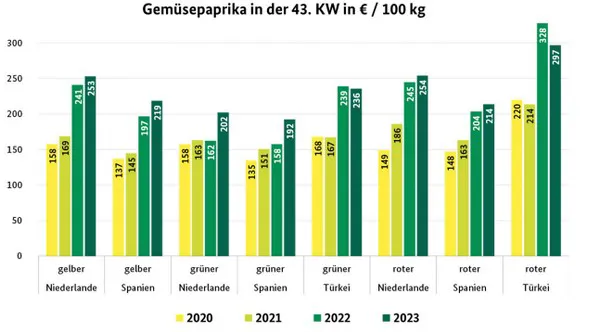Spanish bell pepper deliveries increased in German markets. However, inconsistent quality made pricing quite difficult at points. The increased availability of Spanish goods had a negative impact on the prices of their competitors: according to the BLE, Dutch, Belgian and Polish goods often became cheaper. Traders often had to lower their previous prices for Turkish imports as well.

Overall, prices mostly shifted slightly downward. However, rising prices were observed in some cases as well, particularly for Spanish goods.
Apples
As in previous weeks, domestic fruit formed the basis of the assortment. In addition to this, Italian, Dutch and French apples were available primarily. Belgian apples rounded off the range, as well as Polish ones. The supply was sufficient to satisfy the demand.
Pears
Italian Abate Fetel and Santa Maria and Turkish Santa Maria were predominant. From Germany, Xenia and Alexander Lucas were on hand primarily, accompanied by Gute Luise, Gellert and Boscs Flaschenbirne. From the Netherlands, mainly Xenia, Gute Luise and Conference were shipped in. Belgian and Spanish deliveries completed the assortment.
Grapes
Italian shipments dominated the markets, with Italia and Crimson Seedless being the main choices. Sultana and Crimson Seedless came from Turkey. A few shipments from France and Greece played only a minor role. Neither had Spanish and Portuguese imports much influence on the sales.
Small citrus
Spanish shipments set the tone as far as clementines and satsumas were concerned, while South Africa played was number one regarding mandarins. Turkish shipments recently arrived in all three sectors, but these did not exceed a complementary status. In the case of mandarins: Peruvian, Chilean and Italian goods were available as well.
Lemons
The presence of Spanish goods increased noticeably: in many places, the fruit displaced its South African competition from the top position. Turkish imports increased: in addition to the established 14- and 15-kg boxes, the items were increasingly available in 500-g bags and 9-kg cartons.
Bananas
The holiday season and the end of the month resulted in rather weak demand, which was easily satisfied. Prices generally remained at the last week's levels.
Cauliflower
Domestic batches dominated the scene. Italian, Belgian and Dutch batches were supplementary. The first French products arrived in Frankfurt, where they cost €13 per 6-pack. Polish goods completed events.
Lettuces
Regarding colorful lettuces; domestic goods continued to set the tone, but the first Italian ones arrived. For iceberg lettuce, Spanish items displaced domestic goods from the top position and Dutch lettuce complemented the market. Lettuce came primarily from Germany and Belgium.
Cucumbers
The relevance of German shipments dropped massively and Dutch and Belgian deliveries also narrowed down significantly. On the other hand, Spanish imports increased. Greek and Moroccan imports also appeared in Munich. In Frankfurt, Hungarian cucumbers in the 350 g size appeared.
Tomatoes
Belgian, Dutch and Turkish offerings formed the basis of the supply. Morocco, Italy and Germany had rather a complementary character. Just a few shipments from Spain rounded off the range. Some Eastern European imports were also around. Prices mostly dropped a little.
Source: BLE
